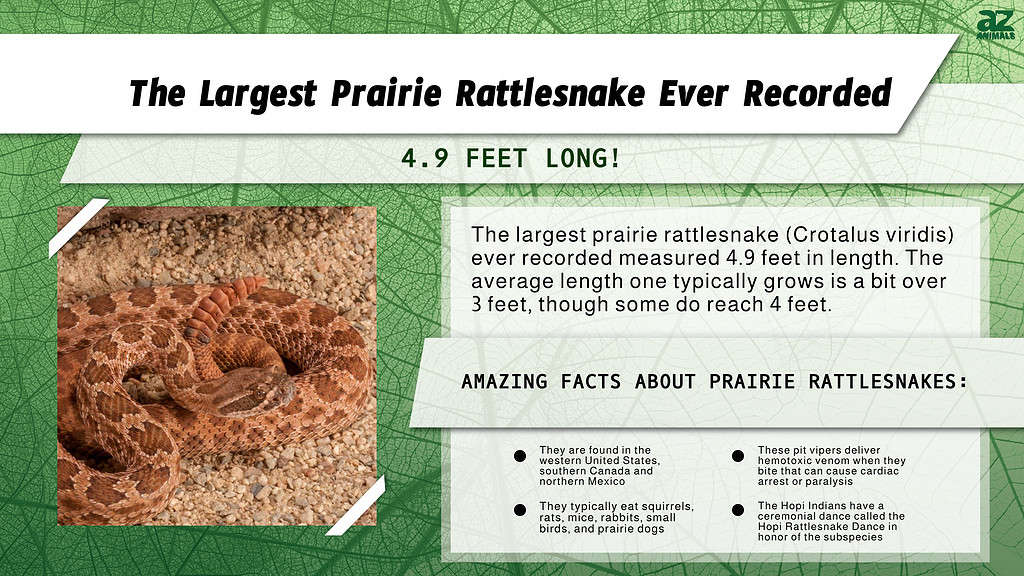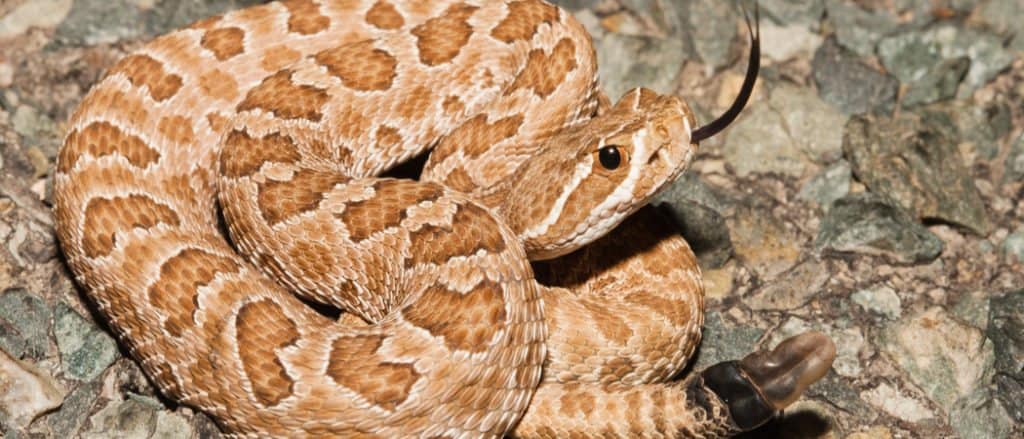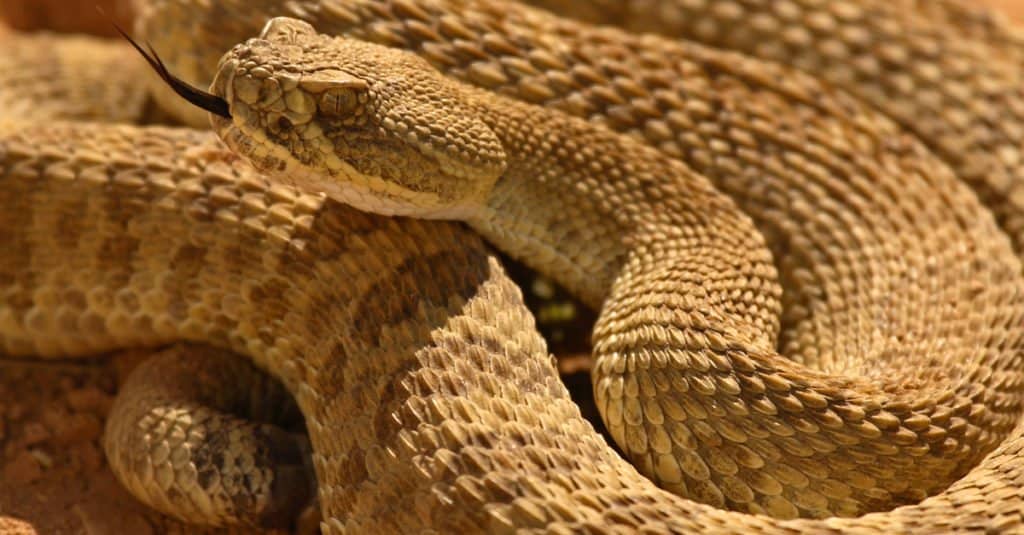The prairie rattlesnake, or Crotalus viridis, is a venomous pit viper that is usually found in the west of the United States. It can also be found from Southern Canada to Northern Mexico. It has two subspecies: the prairie rattlesnake and the Hopi rattlesnake. Its venom has neurotoxic properties, meaning that once the venom travels through the bloodstream, it begins to attack the nervous system. Although this snake is venomous, it is quite small compared to other snakes. The prairie rattlesnake proves that size does not always indicate the level of danger. So, exactly how big is the largest prairie rattlesnake ever recorded? Read on to find out!
Largest Prairie Rattlesnake Ever Recorded

The largest prairie rattlesnake ever recorded was 4.9 feet! It is said that the average length for a prairie rattlesnake is just over 3 feet in length. However, it is possible for this species to grow up to 4 feet.
More About the Prairie Rattlesnake
Appearance and Behavior

The largest prairie rattlesnake ever recorded clocks in at 4.9 feet long.
©Nathan A Shepard/Shutterstock.com
This snake and its subspecies have a rattle on the end of its tail used for defense purposes. The appearance of this species usually depends on its subspecies. For instance, the prairie rattlesnake typically is a light brown color with deep brown patches that resemble a dorsal pattern. Its head is also triangular in shape. Its other subspecies, the Hopi rattlesnake, has a diamond-shaped head and typically has a thicker body that is light in color. It also has indistinct markings all through. While the Hopi rattlesnake is typically more nervous than other rattlesnakes, the prairie rattlesnake is more likely to get defensive when threatened.
This snake and its subspecies are both active during the day when it’s spring or autumn. They can be found climbing up trees or dwelling near rocky areas. Not only does its venom have neurotoxins, but it also has hemotoxins that destroy tissues in an animal or person when bitten. When a prairie rattlesnake strikes, it delivers up to 55 percent of its venom with just one bite!
Habitat

The prairie rattlesnake is typically non-aggressive but will strike if it feels threatened.
©Creeping Things/Shutterstock.com
The prairie rattlesnake and its subspecies are often found in the rocky areas of the west in the United States, pretty much all over the Great Plains. They are commonly found in Montana and are one of 10 snake species in the state and also the only venomous ones! While prairie rattlesnakes typically dwell in high-prey traffic areas, the subspecies typically live in dens and near rocky areas. Prairie rattlesnakes have also been known to occupy other animal burrows. This makes it easier for them to hunt their prey. While they are known to climb inside trees or even bushes, some of these snakes can also rest inside caves. So, look out if you’re hiking in the areas in which these snakes reside!
Diet

Prairie rattlesnakes love to feast on prairie dogs.
©Max Allen/Shutterstock.com
Did you know that prairie rattlesnakes got their name because they love to feast on prairie dogs? While this is a common food source for them, they also tend to hunt a wide variety of prey such as squirrels, rats, mice, rabbits, and small birds. They are opportunistic eaters and have also been known to eat other small reptiles and amphibians. When attacking their prey, they strike and bite it, swallowing the prey whole, starting at the head. It takes about five days for the prey to fully digest. Since these snakes rely on eating rodents, they help regulate the population of both mice and rats!
Reproduction and Lifespan
Since prairie rattlesnakes are viviparous, they can produce up to 25 young snakes at a time. Although it is possible for them to deliver up to 25 young snakes, it also depends on their environment and the food supply. They typically breed once a year, though it is common for them not to breed every single year during mating season. When it is breeding season, however, male prairie rattlesnakes often compete for the breeding of a female. If the female does choose to breed, it will give birth in late summer or early autumn. Once the snakes are born, they do not need any care from the mother and are full of venom. When they reach the age of three years, they are sexually mature and ready to breed on their own.
Danger
While the prairie rattlesnake and its subspecies are venomous, they rarely attack humans. In fact, when approached by humans or large predators, they often scurry away from the threat. However, if they bite, the venom can cause a heart attack or paralysis, and it can also destroy tissues. If a rattlesnake bites you, call 911 immediately or travel to the nearest hospital.
Conservation Status
Thankfully, this species is not threatened and continues to live in the wild today, playing a key role in the conservation of our ecosystem. If you see one of these snakes in the wild, back away slowly and do not provoke it.
The Hopi Rattlesnake Dance
As mentioned earlier, the Hopi rattlesnake is a subspecies of the prairie rattlesnake. It resides in northern Arizona, New Mexico, and Utah. It got its name from sharing the same geographic area with the Hopi Indians. The Hopis used snakes in some of their religious ceremonies, including the Hopi rattlesnake.
One of their ceremonial dances, a highly religious one to their gods including the Plumed Spirit, is called the Hopi Rattlesnake Dance. In general, it’s a dance appealing to the gods to send rain for their crops. But it originated as a plea for protection for their children from deadly snake bites. Unbelievably, many of the men who take part in the dance, even to this day, dance with live rattlesnakes in their mouths. And just as surprisingly, they generally come away from the dance unharmed.
Other Record-Breaking Snakes
Now that you’ve learned about the prairie rattlesnake – let’s discover the largest venomous rattlesnake in the world! This pit viper can only be found in the southern United States and can easily grow to be 6 feet long and weigh 15 pounds. What do they look like? Eastern diamondback rattlesnakes have around 29 rows of dorsal scales in the middle of their body – with a base color ranging from brown, brownish-yellow, brownish-gray, or olive with diamond patterns that are dark brown to black. An expanding, backward-and-downward black stripe goes from the eye to the lower lip of the skull.
Eastern diamondbacks can thrive in a range of habitats, including pine forests, flat woods, sandhills, and wet prairies. They tend to shelter from the cold in gopher and tortoise burrows. These massive rattlers prey on whatever is available in their habitat – and their large size enables them to feed on animals as large as a cottontail rabbit. With few threats and plenty of prey – these big snakes can live as long as 20 years in the wild.
Known as the deadliest venomous snake in North America, the eastern diamondback boasts the longest fangs of any rattlesnake species. Immediate medical attention is needed if one of these snakes bites you – because it can be fatal. So, just how big can an eastern diamondback rattlesnake get? The record holder was longer than 7 feet and weighed 34 pounds!
The photo featured at the top of this post is © iStock.com/HRossD
Discover the "Monster" Snake 5X Bigger than an Anaconda
Every day A-Z Animals sends out some of the most incredible facts in the world from our free newsletter. Want to discover the 10 most beautiful snakes in the world, a "snake island" where you're never more than 3 feet from danger, or a "monster" snake 5X larger than an anaconda? Then sign up right now and you'll start receiving our daily newsletter absolutely free.
Thank you for reading! Have some feedback for us? Contact the AZ Animals editorial team.






